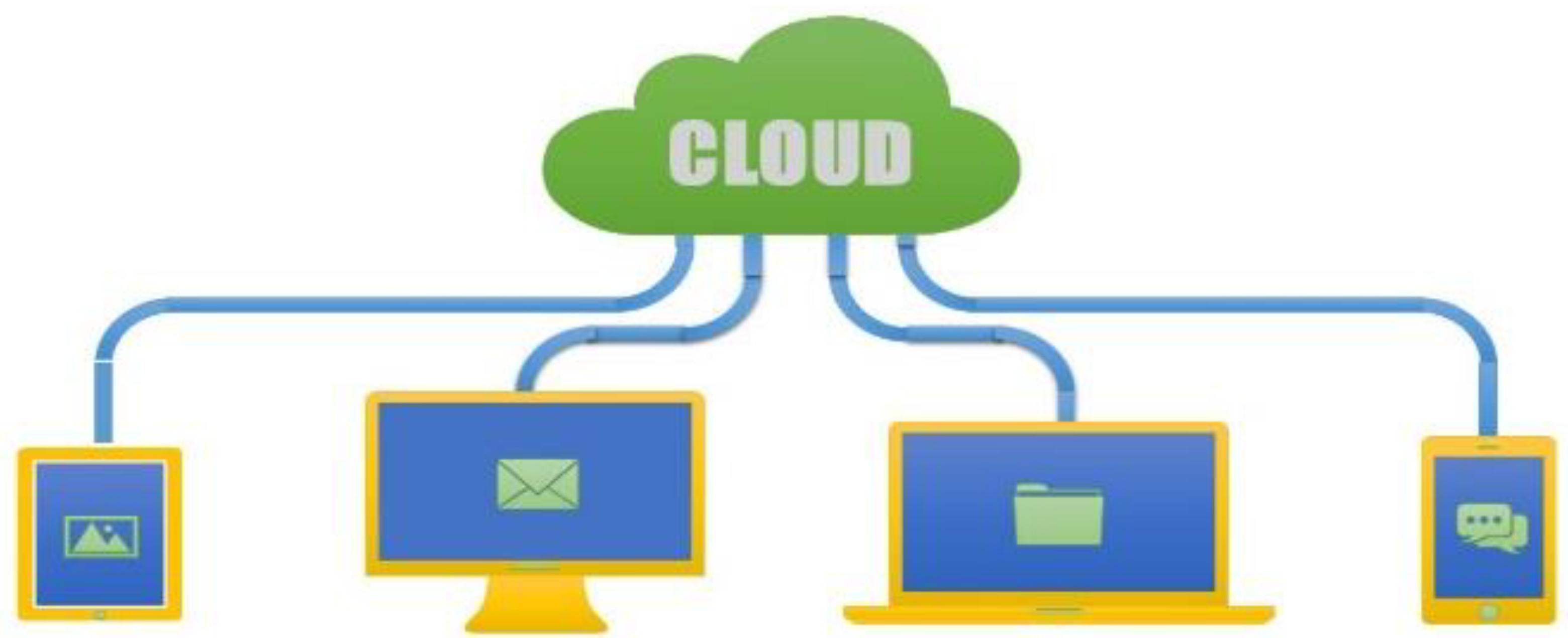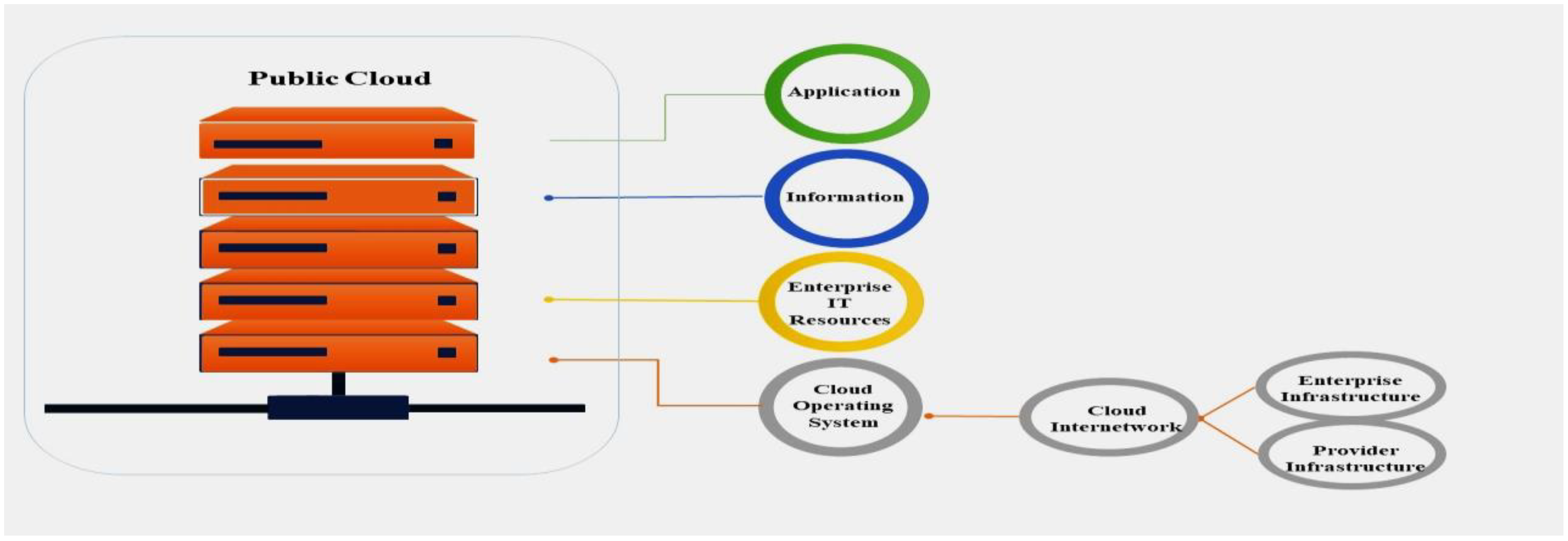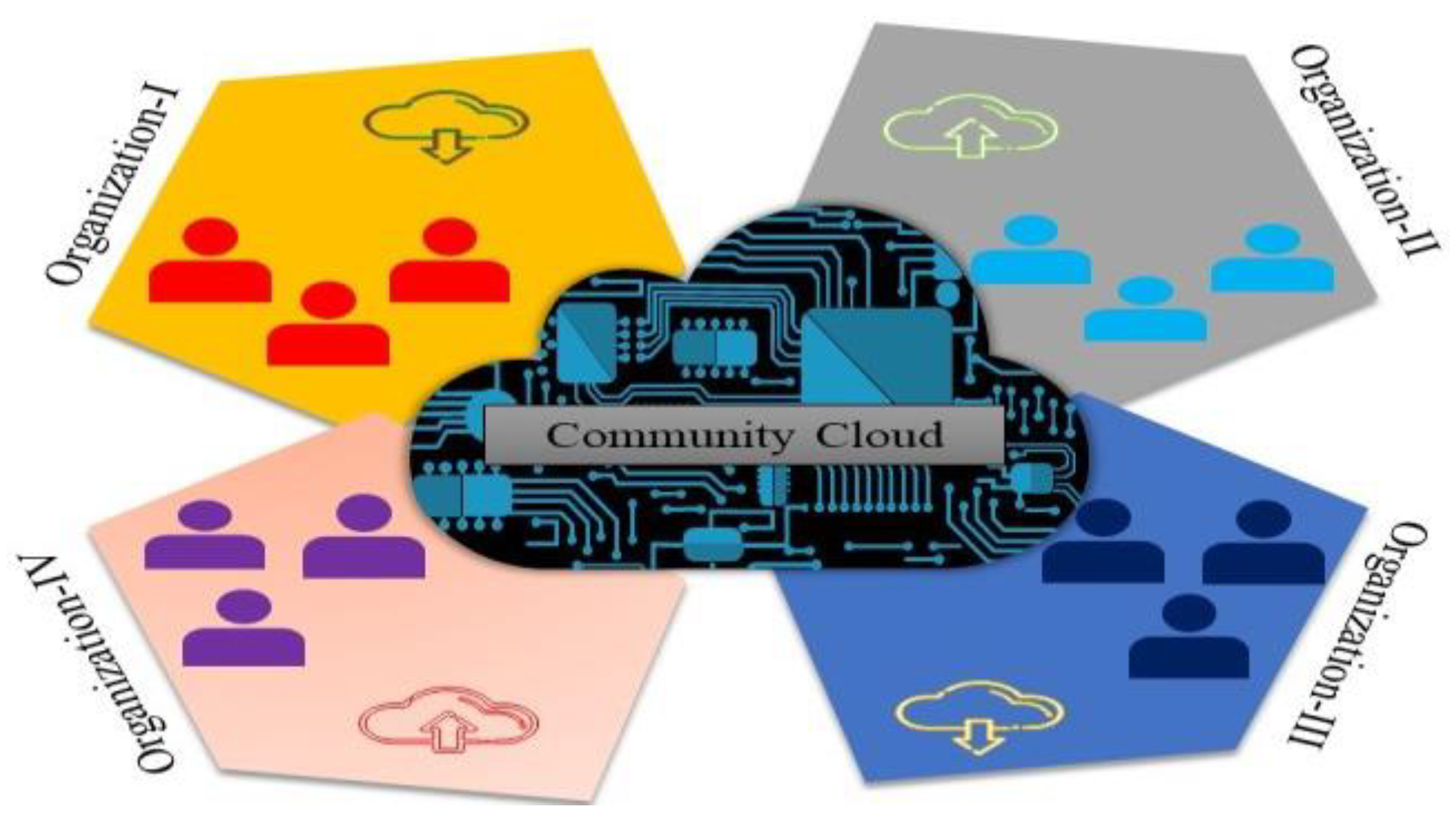Cloud Computing (CC) provides a combination of technologies that allows the user to use the most resources in the least amount of time and with the least amount of money. CC semantics play a critical role in ranking heterogeneous data by using the properties of different cloud services and then achieving the optimal cloud service. Regardless of the efforts made to enable simple access to this CC innovation, in the presence of various organizations delivering comparative services at varying cost and execution levels, it is far more difficult to identify the ideal cloud service based on the user’s requirements.
- cloud services
- ranking
- machine learning
1. Introduction




2. Cloud Services Based on End-Users’ Feedback
This entry is adapted from the peer-reviewed paper 10.3390/s22124627
References
- Ouyang, C.; Adams, M.; Hofstede, A.H.T.; Yu, Y. Design and Realisation of Scalable Business Process Management Systems for Deployment in the Cloud. ACM Trans. Manag. Inf. Syst. 2021, 12, 36.
- Nadeem, S.; Rizwan, M.; Ahmad, F.; Manzoor, J. Securing cognitive radio vehicular ad hoc network with fog node based distributed blockchain cloud architecture. Int. J. Adv. Comput. Sci. Appl. 2019, 10, 288–295.
- Hameed, U.; Naseem, S.; Ahamd, F.; Alyas, T.; Khan, W.-A. Intrusion detection and prevention in cloud computing using genetic algorithm. Int. J. Sci. Eng. Res. 2014, 5, 1271–1275.
- Rawas, S. Energy, network, and application-aware virtual machine placement model in SDN-enabled large scale cloud data centers. Multimed. Tools Appl. 2021, 80, 15541–15562.
- Mao, C.; Lin, R.; Towey, D.; Wang, W.; Chen, J.; He, Q. Trustworthiness prediction of cloud services based on selective neural network ensemble learning. Expert Syst. Appl. 2021, 168, 114390.
- Hassan, T.; Ahmed, F. Transaction and Identity Authentication Security Model for E-Banking: Confluence of Quantum Cryptography and AI. In Proceedings of the International Conference on Intelligent Technologies and Applications, Bahawalpur, Pakistan, 23–25 October 2018; pp. 338–347.
- Hasan, T.; Ahmad, F.; Rizwan, M.; Alshammari, N.; Alanazi, S.A.; Hussain, I.; Naseem, S. Edge Caching in Fog-Based Sensor Networks through Deep Learning-Associated Quantum Computing Framework. Comput. Intell. Neurosci. 2022, 2022, 6138434.
- Aslam, B.; Abid, R.; Rizwan, M.; Ahmad, F.; Sattar, M.U. Heterogeneity Model for Wireless Mobile Cloud Computing & its Future Challenges. In Proceedings of the 2019 International Conference on Electrical, Communication, and Computer Engineering (ICECCE), Swat, Pakistan, 24–25 July 2019; pp. 1–7.
- Firouzi, F.; Farahani, B.; Marinšek, A. The convergence and interplay of edge, fog, and cloud in the AI-driven Internet of Things (IoT). Inf. Syst. J. 2021, 107, 101840.
- Rizwan, M.; Shabbir, A.; Shabbir, M.; Ahmad, F.; Sattar, M.U. A Clustering based Hybrid Mobility in WPAN. In Proceedings of the 2019 International Conference on Innovative Computing (ICIC), Lahore, Pakistan, 1–2 November 2019; pp. 1–7.
- Soh, J.; Copeland, M.; Puca, A.; Harris, M. Overview of Azure Infrastructure as a Service (IaaS) Services. In Microsoft Azure; Springer: Berlin/Heidelberg, Germany, 2020; pp. 21–41.
- Cheema, A.; Tariq, M.; Hafiz, A.; Khan, M.M.; Ahmad, F.; Anwar, M. Prevention Techniques against Distributed Denial of Service Attacks in Heterogeneous Networks: A Systematic Review. Secur. Commun. Netw. 2022, 2022, 8379532.
- Silverstein, J.C.; Foster, I.T. Computer architectures for health care and biomedicine. In Biomedical Informatics; Springer: Berlin/Heidelberg, Germany, 2014; pp. 149–184.
- IONESCU, A. Security of Computer Networks Implemented in Universities and Business Environment. Hyperion Int. J. Econophys. New Econ. 2014, 7, 305–326.
- Risco, S.; Moltó, G.; Naranjo, D.M.; Blanquer, I. Serverless Workflows for Containerised Applications in the Cloud Continuum. J. Grid Comput. 2021, 19, 30.
- Butpheng, C.; Yeh, K.-H.; Xiong, H. Security and privacy in IoT-cloud-based e-health systems—A comprehensive review. Symmetry 2020, 12, 1191.
- Helo, P.; Hao, Y.; Toshev, R.; Boldosova, V. Cloud manufacturing ecosystem analysis and design. Robot. Comput.-Integr. Manuf. 2021, 67, 102050.
- Saraswat, M.; Tripathi, R. Cloud Computing: Analysis of Top 5 CSPs in SaaS, PaaS and IaaS Platforms. In Proceedings of the 2020 9th International Conference System Modeling and Advancement in Research Trends (SMART), Moradabad, India, 4–5 December 2020; pp. 300–305.
- Hassan, T.; Khan, W.A.; Ahmad, F.; Rizwan, M.; Rehman, R. Edge Caching Framework in Fog Based Radio Access Networks Through AI in Quantum Regime. In Proceedings of the International Conference on Intelligent Technologies and Applications, Bahawalpur, Pakistan, 6–8 November 2019; pp. 711–722.
- Bokhari, M.U.; Makki, Q.; Tamandani, Y.K. A survey on cloud computing. In Big Data Analytics; Springer: Berlin/Heidelberg, Germany, 2018; pp. 149–164.
- Shabbir, M.; Ahmad, F.; Shabbir, A.; Alanazi, S.A. Cognitively managed multi-level authentication for security using Fuzzy Logic based Quantum Key Distribution. J. King. Saud. Univ.—Comput. Inf. Sci. 2022, 34, 1468–1485.
- Khan, W.A.; Ahmad, F.; Alanazi, S.A.; Hasan, T.; Naseem, S.; Nisar, K.S. Trust identification through cognitive correlates with emphasizing attention in cloud robotics. Egypt. Inform. J. 2022, 23, 259–269.
- Zhang, C.; Li, Z.; Li, T.; Han, Y.; Wei, C.; Cheng, Y.; Peng, Y. P-CSREC: A new approach for personalized cloud service recommendation. IEEE Access 2018, 6, 35946–35956.
- Rizwan, M. Cloud Computing Serving as a Solution to the IoT Generated Data. Bahria Univ. J. Inf. Commun. Technol. 2018, 11, 1–6.
- Carney, W.T. A Case Study of the United States Air Force Adoption of Cloud Computing. Ph.D. Thesis, Robert Morris University, Moon Twp, PA, USA, 2019.
- Alanazi, S.A.; Alruwaili, M.; Ahmad, F.; Alaerjan, A.; Alshammari, N. Estimation of Organizational Competitiveness by a Hybrid of One-Dimensional Convolutional Neural Networks and Self-Organizing Maps Using Physiological Signals for Emotional Analysis of Employees. Sensors 2021, 21, 3760.
- Mehmood, M.; Alshammari, N.; Alanazi, S.A.; Ahmad, F. Systematic Framework to Predict Early-Stage Liver Carcinoma Using Hybrid of Feature Selection Techniques and Regression Techniques. Complexity 2022, 2022, 7816200.
- Shahzadi, S.; Ahmad, F.; Basharat, A.; Alruwaili, M.; Alanazi, S.; Humayun, M.; Rizwan, M.; Naseem, S. Machine Learning Empowered Security Management and Quality of Service Provision in SDN-NFV Environment. Comput. Mater. Contin. 2021, 66, 2723–2749.
- Ahmad, F.; Almuayqil, S.N.; Mamoona, H.; Shahid, N.; Wasim Ahmad, K.; Kashaf, J. Prediction of COVID-19 cases using machine learning for effective public health management. Comput. Mater. Contin. 2021, 66, 2265–2282.
- Tsiakmaki, M.; Kostopoulos, G.; Kotsiantis, S.; Ragos, O. Implementing AutoML in educational data mining for prediction tasks. Appl. Sci. 2020, 10, 90.
- Tavara, S. Parallel computing of support vector machines: A survey. ACM Comput. Surv. 2019, 51, 123.
- Lei, B.; Ren, Y.; Wang, N.; Huo, L.; Song, G. Design of a new low-cost unmanned aerial vehicle and vision-based concrete crack inspection method. Struct. Health Monit. 2020, 19, 1871–1883.
- Rajesh, K.N.; Dhuli, R. Classification of ECG heartbeats using nonlinear decomposition methods and support vector machine. Comput. Biol. Med. 2017, 87, 271–284.
- Kayes, A.; Kalaria, R.; Sarker, I.H.; Islam, M.; Watters, P.A.; Ng, A.; Hammoudeh, M.; Badsha, S.; Kumara, I. A survey of context-aware access control mechanisms for cloud and fog networks: Taxonomy and open research issues. Sensors 2020, 20, 2464.
- Jiang, C.; Fan, T.; Gao, H.; Shi, W.; Liu, L.; Cerin, C.; Wan, J. Energy aware edge computing: A survey. Comput. Commun. 2020, 151, 556–580.
- Al-Sayed, M.M.; Hassan, H.A.; Omara, F.A. Towards evaluation of cloud ontologies. J. Parallel Distrib. Comput. 2019, 126, 82–106.
- Talebian, H.; Gani, A.; Sookhak, M.; Abdelatif, A.A.; Yousafzai, A.; Vasilakos, A.V.; Yu, F.R. Optimizing virtual machine placement in IaaS data centers: Taxonomy, review and open issues. Clust. Comput. 2020, 23, 837–878.
- Liu, C.; Su, Z.; Xu, X.; Lu, Y. Service-oriented industrial internet of things gateway for cloud manufacturing. Robot. Comput. -Integr. Manuf. 2022, 73, 102217.
- Wang, G.; He, X.; Ishuga, C.I. HAR-SI: A novel hybrid article recommendation approach integrating with social information in scientific social network. Knowl. Based Syst. 2018, 148, 85–99.
- Zhang, W.E.; Sheng, Q.Z. Managing Data from Knowledge Bases: Querying and Extraction; Springer: Berlin/Heidelberg, Germany, 2018.
- Anisha, C.; Saranya, K. An Intense Study on Intelligent Service Provisioning for Multi-Cloud Based on Machine Learning Techniques. In Operationalizing Multi-Cloud Environments; Springer: Berlin/Heidelberg, Germany, 2022; pp. 177–200.
- Sahingoz, O.K.; Buber, E.; Demir, O.; Diri, B. Machine learning based phishing detection from URLs. Expert Syst. Appl. 2019, 117, 345–357.
- Mohammed, F.; Ali, A.M.; Al-Ghamdi, A.S.A.-M.; Alsolami, F.; Shamsuddin, S.M.; Eassa, F.E. Cloud computing services: Taxonomy of discovery approaches and extraction solutions. Symmetry 2020, 12, 1354.
- Shabbir, A.; Shabbir, M.; Rizwan, M.; Ahmad, F. Ensuring the Confidentiality of Nuclear Information at Cloud Using Modular Encryption Standard. Secur. Commun. Netw. 2019, 2019, 2509898.
- Hosseinzadeh, M.; Hama, H.K.; Ghafour, M.Y.; Masdari, M.; Ahmed, O.H.; Khezri, H. Service selection using multi-criteria decision making: A comprehensive overview. J. Netw. Syst. Manag. 2020, 28, 1639–1693.
- Ouadah, A.; Hadjali, A.; Nader, F.; Benouaret, K. SEFAP: An efficient approach for ranking skyline web services. J. Ambient. Intell. Humaniz. Comput. 2019, 10, 709–725.
- Deepa, N.; Prabadevi, B.; Srivastava, G. Integrated Ranking Algorithm for Efficient Decision Making. Int. J. Inf. Technol. Decis. Mak. 2021, 20, 597–618.
- Obayiuwana, E.; Falowo, O.E. Network selection in heterogeneous wireless networks using multi-criteria decision-making algorithms: A review. Wirel. Netw. 2017, 23, 2617–2649.
- Gireesha, O.; Somu, N.; Krithivasan, K.; VS, S.S. IIVIFS-WASPAS: An integrated Multi-Criteria Decision-Making perspective for cloud service provider selection. Future Gener. Comput. Syst. 2020, 103, 91–110.
- Mehmood, M.; Alshammari, N.; Alanazi, S.A.; Basharat, A.; Ahmad, F.; Sajjad, M.; Junaid, K. Improved Colorization and Classification of Intracranial Tumor Expanse in MRI Images via Hybrid Scheme of Pix2Pix-cGANs and NASNet-Large. J. King. Saud. Univ.-Comput. Inf. Sci. 2022; in press.
- Wang, J.; Jing, X.; Yan, Z.; Fu, Y.; Pedrycz, W.; Yang, L.T. A survey on trust evaluation based on machine learning. ACM Comput. Surv. 2020, 53, 107.
- Chattu, V.K. A review of artificial intelligence, Big Data, and blockchain technology applications in medicine and global health. Big Data Cogn. Comput. 2021, 5, 41.
- Mehmood, M.; Ayub, E.; Ahmad, F.; Alruwaili, M.; Alrowaili, Z.A.; Alanazi, S.; Humayun, M.; Rizwan, M.; Naseem, S.; Alyas, T. Machine learning enabled early detection of breast cancer by structural analysis of mammograms. Comput. Mater. Contin. 2021, 67, 641–657.
- Rahman, A.; Saleem, N.; Shabbir, A.; Shabbir, M.; Rizwan, M.; Naseem, S.; Ahmad, F. ANFIS based hybrid approach identifying correlation between decision making and online social networks. EAI Endorsed Trans. Scal. Inf. Syst. 2021, 8, e4.
- Yanes, N.; Bououd, I.; Alanazi, S.A.; Ahmad, F. Fuzzy Logic Based Prospects Identification System for Foreign Language Learning Through Serious Games. IEEE Access 2021, 9, 63173–63187.
- Shahzadi, S.; Khaliq, B.; Rizwan, M.; Ahmad, F. Security of cloud computing using adaptive neural Fuzzy inference system. Secur. Commun. Netw. 2020, 2020, 5352108.
